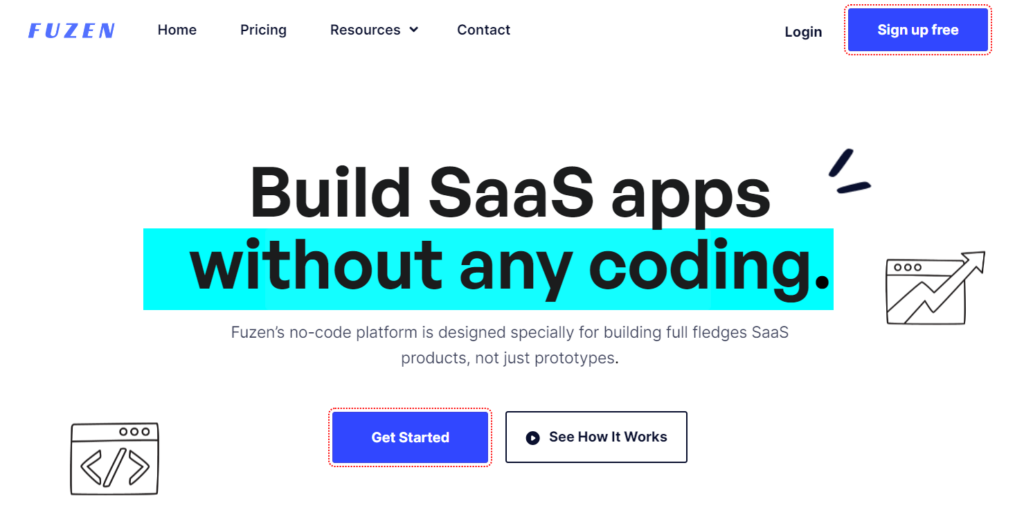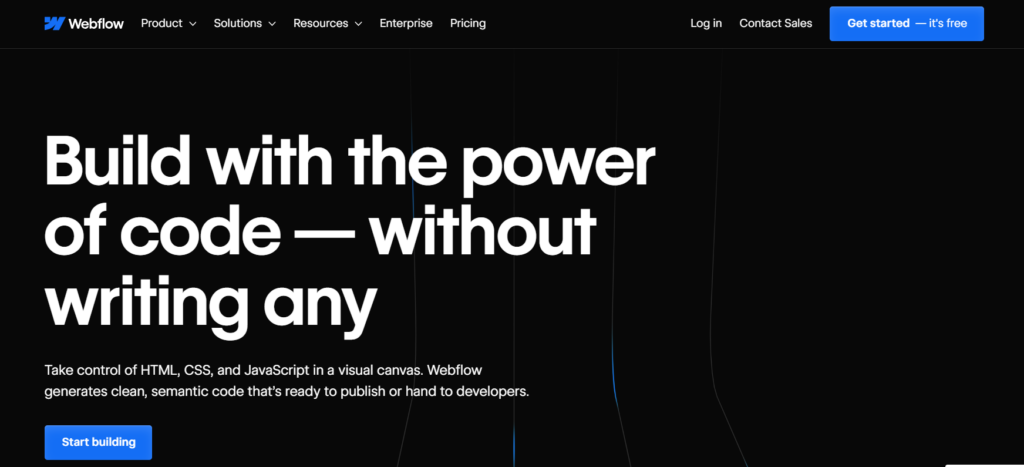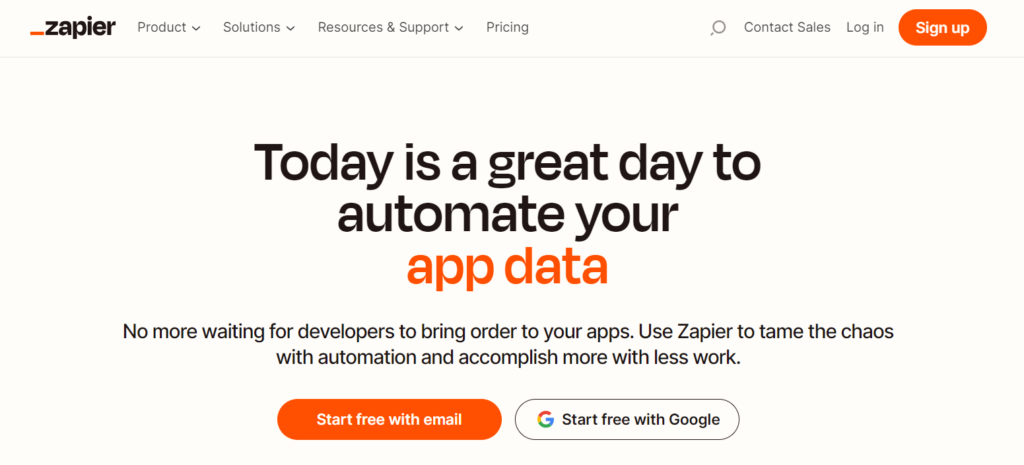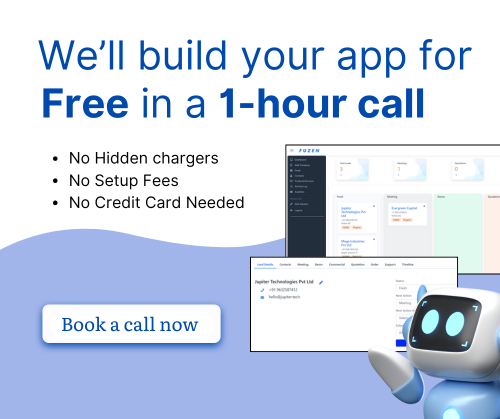Ever wanted to create your own awesome web app but felt overwhelmed by all the coding stuff? Well, those days are long gone. Now, you can now undertake full stack web development without touching a single line of code.
That’s what this post is all about. We’ll guide you from start to finish through the concept of full stack web app development with no code and dive into the tools that will help you build a web application without coding quickly and efficiently.
Understanding full stack web app development
Full-stack web app development involves three main parts: the front end, the back end, and the database. Each plays a crucial role in creating a complete and functional web application.
- Front-end: The front-end is what users interact with directly. It includes everything users see as well as determines how users perceive and interact with the application. It involves languages like HTML, CSS, and JavaScript.
- Back-end: The back‑end is responsible for handling business logic, security, user authentication, and generating server side rendered pages. Programming languages like Python, Node.js, or Java, along with frameworks like Django, Express, or Spring Boot are used here.
- Database: The database allows the application to retrieve and store data efficiently, ensuring robust database software and effective management so that information is available when needed. Common types of databases used in web development include relational databases like MySQL and PostgreSQL, as well as NoSQL databases like MongoDB.
Each component - front-end, back-end, and database - works together to create a comprehensive web application. Without any of these components, a web application would be incomplete.
But today, you don’t need to learn any of these languages to build a web app.
With the emergence of no-code platforms, building a complete web app is easily possible.
Full stack web app development with no code
No-code full-stack app development refers to the practice of creating software applications without writing extensive lines of code.
This approach allows individuals with little to no coding experience to build fully functional applications that encompass both the frontend (client-side) and backend (server-side) components.
Key components of no code full stack development include
- Visual development interfaces: These interfaces provide a visual representation of the application being built, allowing users to design user interfaces (UI) and workflows visually.
- Pre-built templates and components: No-code platforms often provide a library of pre-built templates and components that users can leverage to accelerate development and avoid reinventing the wheel.
- Backend automation: No‑code platforms often offer backend automation, integrate a CI CD pipeline, allow users to handle database management, define database schemas, set up APIs, and manage business logic without writing code.
- Integration with third-party services: These platforms typically offer integrations with third-party services and APIs, enabling users to incorporate functionalities like payment processing, user authentication, and data analytics into their applications without writing code.
Advantages of full stack web app development with no code
No-code platforms offer several advantages for full stack web app development:
- Accessibility
No-code platforms democratize software development by making it accessible to non-technical users, entrepreneurs, and small businesses who may not have the resources or expertise to hire professional developers.
- Rapid development
No-code platforms accelerate the development process by allowing users to build and deploy web applications quickly. Without the need for writing code, developers can focus on defining business logic and designing user interfaces, reducing time-to-market and increasing agility.
- Cost-effectiveness
No-code development eliminates the need for hiring expensive developers or investing in specialized technical skills. This reduces development costs and enables individuals and organizations to create custom web applications within budget constraints.
- Flexibility
No-code platforms offer flexibility and scalability, allowing developers to create a wide range of web applications, from simple landing pages to complex enterprise solutions. Users can easily customize and extend their applications as their needs evolve, without requiring extensive redevelopment or technical expertise.
No code platforms to develop a full stack web app
1. SaaS - Fuzen
If you are looking to develop a full stack SaaS app while ensuring flexibility, scalability, and seamless integration, look no further than Fuzen.
It’s a revolutionary platform that simplifies the process of building and deploying SaaS apps with its comprehensive set of features and capabilities.
Here's what Fuzen offers;
Full-Stack development offering
Fuzen offers a complete solution for full-stack SaaS app development, encompassing both front-end and back-end functionalities. With its intuitive interface users can effortlessly design stunning user interfaces while leveraging powerful backend features to handle data processing, user authentication, and more.
Integration capabilities
One of Fuzen’s standout full stack development offerings is its seamless integration capabilities. Whether it's integrating with third-party APIs or payment gateways, Fuzen makes it easy to connect and communicate with external services, enabling developers to design and develop SaaS apps with ease.
Backend functionality
Behind every great SaaS app is a robust backend infrastructure, and Fuzen delivers on this front. From generating server side rendered content and managing databases to handling user authentication and security, Fuzen provides all the tools necessary to build a reliable and scalable backend for your SaaS application.
Customization
No two SaaS apps are alike, and Fuzen understands the importance of customization. With its flexible architecture and customizable components, users can tailor their apps to meet specific business requirements, ensuring a unique and tailored user experience for their customers.
Flexibility and scalability
As businesses grow and evolve, so too must their SaaS applications. Fuzen offers unparalleled flexibility and scalability, allowing apps to scale seamlessly to accommodate growing user bases and evolving business needs without compromising performance or reliability.
Community and support
Last but not least, Fuzen boasts a vibrant community of developers and entrepreneurs who are passionate about building and sharing innovative SaaS applications. With extensive documentation, tutorials, and dedicated support channels, users can tap into this community for guidance, inspiration, and troubleshooting assistance throughout their app development journey.
2. E-commerce platform - Shopify
When it comes to developing e-commerce platforms, Shopify will always come to mind first. Its reputation as a leading e-commerce platform precedes it, offering a comprehensive set of features and tools for building robust online stores.
Let's delve into how you can develop a full-stack e-commerce platform with Shopify;
Storefront design
At the heart of every successful e-commerce platform lies an engaging and visually appealing storefront. Shopify empowers users to create stunning storefronts with its intuitive drag-and-drop editor, customizable themes, and extensive library of design assets. With Shopify, users can effortlessly craft immersive shopping experiences that captivate customers and drive sales.
Product management
Managing a diverse inventory of products is a breeze with Shopify's robust product management tools. From adding new products and organizing categories to tracking inventory levels and setting pricing, Shopify streamlines the entire product management process, allowing users to focus on growing their business without getting bogged down by administrative tasks.
Payment processing
Seamless and secure payment processing is essential for any e-commerce platform, and Shopify delivers on this front. With support for multiple payment gateways, including Shopify Payments, users can offer customers a variety of payment options while ensuring transactions are safe and hassle-free.
Order fulfillment
Efficient order fulfillment is key to providing exceptional customer service, and Shopify simplifies the process with its integrated order management system. From processing orders and generating shipping labels to tracking shipments and managing returns, Shopify equips users with all the tools they need to streamline their fulfillment operations and keep customers happy.
Marketing and promotion
Driving traffic and converting visitors into customers is made easy with Shopify's suite of marketing and promotion features. From email marketing and social media integration to SEO optimization and abandoned cart recovery, Shopify provides users with powerful tools to attract, engage, and retain customers, helping them grow their business and increase sales.
Analytics and insights
Understanding customer behavior and tracking key metrics is essential for optimizing performance and driving growth. From tracking sales trends and monitoring website traffic to analyzing customer demographics and measuring marketing ROI, Shopify offers a range of analytics and insights tools to help users do just that.
3. Portfolio and personal website - Webflow
Webflow makes it easy for anyone to create a beautiful and professional portfolio or personal website. With its simple design tools, Webflow has everything you need to showcase your work and talents online.
Why Webflow?
Easy designing
When you're making your personal website or portfolio, how it looks matters a lot. With Webflow, you don't need to know fancy coding. You can design your site just by moving things around with your mouse. There are lots of ready-made designs to choose from, so you can pick one that suits your style.
Simple content management
Keeping your website up-to-date is simple with Webflow. You can easily add new stuff, like your latest projects or blog posts, without any technical fuss. Just type in what you want to say and it'll show up on your site.
Works on all devices
People use all kinds of gadgets to browse the internet, like phones and tablets. With Webflow, your site will look good no matter what device people are using. That way, everyone gets to see your work the way it's meant to be seen.
Effects
Want to add some fun stuff to your site, like animations or interactive elements? Webflow makes it easy to do that without any complicated coding. You can make your site more engaging and memorable with just a few clicks.
Own web address
Having your own web address (like www.yourname.com) looks more professional. Webflow lets you register your own domain right from the platform. Plus, it takes care of hosting your site too, so you don't have to worry about that.
4. Task automation and workflow tools - Zapier
Today, getting tasks done quickly and efficiently is super important. That's where Zapier comes in. It's like having a super helper that can automate boring tasks for you, so you can focus on the fun stuff.
It includes;
Task automator
Zapier helps you set up "Zaps," which are like magic spells that make your apps work together. You can tell Zapier what to do when something happens in one app, like sending an email when you get a new customer or saving a file when someone fills out a form.
App connector
With Zapier, you can connect lots of different apps together. It's like having a big network where all your apps can talk to each other. This means you can move data between apps easily, without having to do it manually.
Workflow wizard
Zapier helps you create workflows that make your work smoother. You can set up rules and steps for how things should happen, like automatically assigning tasks or sending notifications when something important comes up.
Task manager
Keeping track of tasks can be tough, but Zapier makes it simple. You can create tasks, set reminders, and organize everything in one place. It's like having a virtual assistant to help you stay on top of things.
Data syncer
Zapier helps keep your data in sync across different apps. So if you update something in one app, it'll automatically update everywhere else. No more worrying about keeping things up-to-date manually.
Report maker
Zapier gives you insights into how your workflows are performing. You can see stats and trends to help you make better decisions and improve your processes.
Conclusion
These platforms offer a range of features and capabilities for building different types of web applications, from simple landing pages to complex multi-user platforms.
With these tools, you can quickly and efficiently build custom web applications using a no-code approach, without writing a single line of code.






